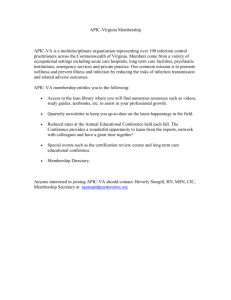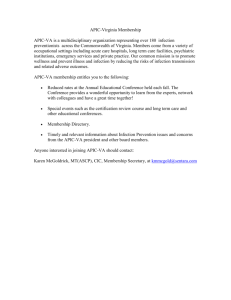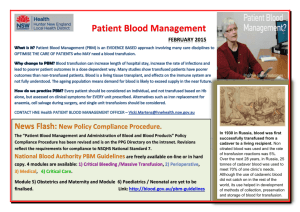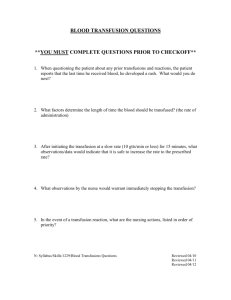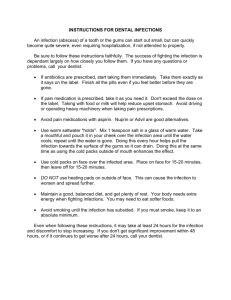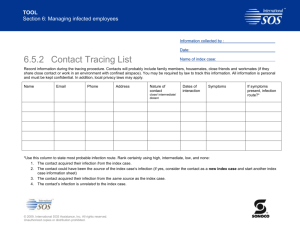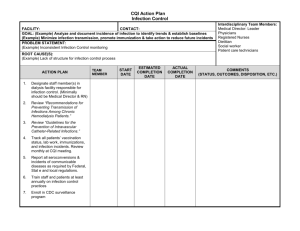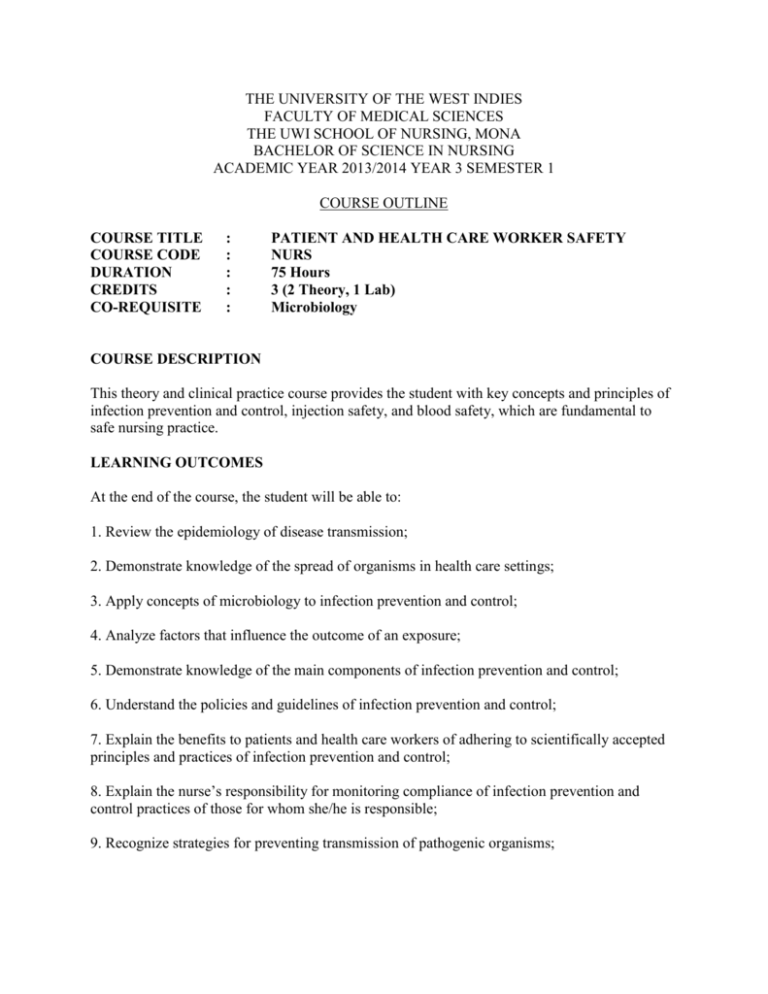
THE UNIVERSITY OF THE WEST INDIES
FACULTY OF MEDICAL SCIENCES
THE UWI SCHOOL OF NURSING, MONA
BACHELOR OF SCIENCE IN NURSING
ACADEMIC YEAR 2013/2014 YEAR 3 SEMESTER 1
COURSE OUTLINE
COURSE TITLE
COURSE CODE
DURATION
CREDITS
CO-REQUISITE
:
:
:
:
:
PATIENT AND HEALTH CARE WORKER SAFETY
NURS
75 Hours
3 (2 Theory, 1 Lab)
Microbiology
COURSE DESCRIPTION
This theory and clinical practice course provides the student with key concepts and principles of
infection prevention and control, injection safety, and blood safety, which are fundamental to
safe nursing practice.
LEARNING OUTCOMES
At the end of the course, the student will be able to:
1. Review the epidemiology of disease transmission;
2. Demonstrate knowledge of the spread of organisms in health care settings;
3. Apply concepts of microbiology to infection prevention and control;
4. Analyze factors that influence the outcome of an exposure;
5. Demonstrate knowledge of the main components of infection prevention and control;
6. Understand the policies and guidelines of infection prevention and control;
7. Explain the benefits to patients and health care workers of adhering to scientifically accepted
principles and practices of infection prevention and control;
8. Explain the nurse’s responsibility for monitoring compliance of infection prevention and
control practices of those for whom she/he is responsible;
9. Recognize strategies for preventing transmission of pathogenic organisms;
10. Describe circumstances requiring use of personal protective equipment and other barriers to
prevent patient or health care worker contact with potentially infectious material;
11. Describe specific practices and settings that increase the opportunity for exposure to health
care workers and patients.
12. Understand occupational control measures and their hierarchy;
13. Demonstrate knowledge of the application of these controls measures and hierarchy in the
prevention and management of exposures;
14. Recognize occupational health strategies for preventing bloodborne diseases and other
communicable diseases in health care workers.
UNIT 1
Hours :
:
MAJOR COMPONENTS OF INFECTION PREVENTION
& CONTROL
5 Theory
5 Practical
Specific Objectives
At the end of the unit, the student will be able to:
1. Review the modes and mechanisms of transmission of pathogenic organisms in the health care
setting;
2. Define major concepts of infection prevention and control;
3. List the main components of infection prevention and control;
4. Discuss each component listed above;
5. Identify specific barriers or personal protective equipment for patient and healthcare worker
protection from exposure of potentially infectious material;
6. Discuss the importance of the correct application of reprocessing methods for assuring the
safety and integrity of patient care equipment;
7. Discuss the creation and maintenance of a safe environment for patient care through
application of infection prevention and control policies and guidelines.
Content
1. Review of modes & mechanisms of transmission of pathogenic organisms in the health care
settings
2. Definition of terms
Asepsis
Medical asepsis
Surgical asepsis
Aseptic technique
Isolation
Reverse isolation
Barrier
Barrier nursing
Nosocomial infection
Bloodborne pathogens/disease
Universal precautions
Standard Precautions
Basic precautions
Transmission-based precautions
Air-borne precautions
Droplet precautions
Contact precautions
Personal protective equipment (PPE)
3. Main components of infection prevention & control
Isolation
Standard Precautions
Transmission-based Precautions
Disinfection & Sterilization
Housekeeping
Health Care Waste Management
Risk Management
UNIT 2
Hours
:
:
MANAGEMENT OF INFECTION PREVENTION & CONTROL
10 Theory
20 Practical
Specific Objectives
At the end of the unit, the student will be able to:
1. Discuss levels of responsibility for infection prevention and control;
2. Identify the individual’s professional responsibility for maintaining a safe patient care
environment;
3. Discuss the quality assurance framework for infection prevention and control;
4. Outline the use of occupational controls to reduce the opportunity for patient and health care
worker contact with potentially infectious material for bloodborne pathogens.
Content
1. Levels of responsibility
Ministry of Health
Parish
District
Health care facility
Community
Individual
Health professionals educational institutions
Regulatory Bodies
Professional Associations
2. Quality assurance framework
Infection prevention & control policies
Roles & responsibilities of
3. Occupational control measures & hierarchies
Elimination of hazards
Work practice controls
Administrative controls
Engineering controls
Personal protective equipment.
UNIT 3
Hours
:
:
INJECTION SAFETY
5 Theory
15 Practical
Specific Objectives
At the end of the unit, the student will be able to:
1. Define the term injection safety;
2. Explain the World Health Organization/Safe Injection Global Network (WHO/SIGN)
strategies for injection safety;
3. Identify the nine ‘rights’ of injection safety;
4. Discuss ‘best’ practices for injection safety;
5. Discuss adverse events associated with injections;
6. Discuss the role of the provider, administrator, and receiver of injections;
7. Discuss the role of the community in injection safety;
8. Discuss the management process for health care workers with needlestick and other sharps
injuries.
Content
1. Definition of term injection safety
2. WHO/Safe Injection Global Network (SIGN) safe injection strategies
Behaviour change of patient & health care workers
Availability of essential supplies & equipment
Appropriate & safe waste disposal
3. Nine ‘rights’ of injection safety
Right patient
Right drug
Right formulation
Right injection equipment
Right dosage
Right time
Right route
Right storage
Right method of disposal
4. ‘Best’ practice
Definition
Associated activities
5. Adverse events
Definition
Types
Management
6. Roles & responsibilities of
Prescriber of injections
Provider/administrator of injections
Receiver of injections
Community
7. Needlestick& other sharps injuries
Definition
Post-exposure prophylaxis (PEP) management.
UNIT 4
Hours
:
:
BLOOD SAFETY
10 Theory
5 Practical
Specific Objectives
At the end of the unit, the student will be able to:
1. Define blood transfusion related terms;
2. Describe the various blood products, uses & storage;
3. Explain the ‘rights’ of blood transfusion;
4. Explain the hospital standard operation procedures for the blood transfusion process;
5. Discuss the respective roles and responsibilities of clinical and blood bank staff in ensuring the
safety and availability of blood products for transfusion;
6. Discuss the hospital procedure for ordering, collection, storage, transportation and
administration of blood products, and for monitoring the transfused patient;
7. Identify the reactions and infections resulting from blood transfusion;
8. Discuss the management of blood transfusion reactions.
Content
1. Definition
Blood products
Rhesus factor
ABO groups
ABO blood groups antigens & antibodies
Compatibility
Incompatibility
Blood cold chain
2. Blood & blood products uses & storage conditions
Types
Uses
Storage
3. ‘Rights’ of blood transfusion
‘Right’ blood
‘Right’ patient
‘Right’ time
‘Right’ environment
4. Hospital standard procedures (SOP) for blood transfusion process
Ordering blood & blood products for elective surgery
Ordering blood & blood products in an emergency
Completing blood request form
Taking pre-transfusion sample
Collecting blood & blood products from blood bank
Storing & transporting blood &blood products including storage in clinical area
Identity checks
Administering blood &blood products including final patient identity check
Recording transfusion in patient records
Monitoring process for transfused patient
ter starting transfusion
Monitoring information
At each stage, record the following
Record
5. Roles & responsibilities of clinical & blood bank staff in blood safety & availability
6. Hospital procedure for ordering, collection, storage, transportation & administration of blood
products,& for monitoring the transfused patient
7. Reactions of blood transfusion
a. Acute complications
Category 1: Mild reactions
Moderate–severe hypersensitivity (severe urticarial reactions)
Category 2: Moderately severe reactions
Febrile non-haemolytic reactions:
Possible bacterial contamination (early signs)
Pyrogens
Category 3: Life threatening reactions
Acute intravascular haemolysis
Bacterial contamination & septic shock
Fluid overload
Anaphylactic reactions
Transfusion-associated lung injury
b. Delayed complications
Categories
i. Transfusion-transmitted infections
HIV-1 &HIV-2
HTLV-I & II
Viral hepatitis B & C
Syphilis
Chagas disease
Malaria
Cytomegalovirus
Other rare infections: e.g. human parvovirus B19 & hepatitis A
ii. Other delayed complications of transfusion
Delayed haemolytic reaction
Post-transfusion purpura
Graft vs. host disease
Iron overload (in patients who receive repeated transfusions)
8. Infections resulting from blood transfusion
Screening
Infections
-Jakob disease (CJD)
9. Management & investigations of blood transfusion reactions according to category
Signs & symptoms
Investigation
Prevention
Management
Recording
Reporting.
Teaching/Learning Methodologies
Lecture/Discussion
PowerPoint presentation
Demonstration
Case study
Video presentations
Role plays
Areas used for Learning
Classroom
Library
Clinical Learning Centre (Nursing Skills Laboratory)
Clinical areas
Learning Experiences
Visits to clinical areas to observe injection safety
Visits to Blood Bank to observe blood collection and storage process
Required Skills
1. Hand hygiene
2. Standard Precautions
COURSE ASSESSMENT
IN COURSE ASSESSMENT
40%
A. GROUP PROJECT AND INDIVIDUAL REFLECTIVE PAPER 20%
This is a written assignment that is due for submission by week 7.
B. MID SEMESTER EXAMINATION 20%
This consist of a thirty items multiple choice examination to be administered under strict
examination conditions during week 8.
FINAL EXAMINATION 60%
This will be a one hundred items multiple choice examination.
Required Reading
International Labour Organization (ILO). (2005). Joint ILO/WHO guidelines on health services
and HIV/AIDS. Geneva: Author.
Reid, Una V. (2008). Manual of infection prevention and control policies and guidelines. Port of
Spain, Trinidad & Tobago: Author. Available on the Internet.
WHO/AFRO/JSI/ Reid, Una V.: (2005). DO NO HARM: Injection safety in the context of
infection prevention and control. Facilitators’ guide. Washington, DC: Author.
WHO/Una V. Reid (2008). WHO best practices for injections and related procedures toolkit.
Geneva: Author.
Recommended Reading
Berman, A., Synder, S., Kozier, B. &Erb, G. (2008). Fundamentals of nursing: Concepts,
process and practice. (8the.d.). New Jersey: Pearson Prentice Hall.
WHO.(2011). Patient safety curriculum guide.Multi-professional edition. Retrieved from
http://whqlibdoc.who.int/publications/2011/9789241501958_eng.pdf
WHO websites on Blood Safety, Injection Safety, Infection Prevention & Control
CDC websites: topic related.

